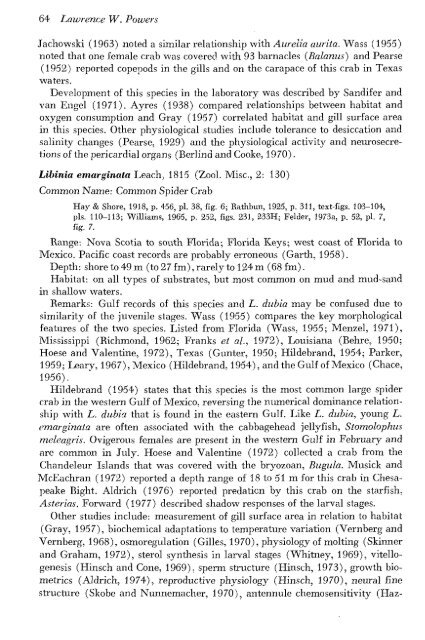Create successful ePaper yourself
Turn your PDF publications into a flip-book with our unique Google optimized e-Paper software.
64 Lawrence W. Powers<br />
Jachowski (1963) noted a similar relationship with Aurelia aurita. Wass (1955)<br />
noted that one female crab was covered with 93 barnacles {Balanus) and Pearse<br />
(1952) reported copepods in the gills and on the carapace of this crab in Texas<br />
waters.<br />
Development of this species in the laboratory was described by Sandifer and<br />
van Engel (1971). Ayres (1938) compared relationships between habitat and<br />
oxygen consumption and Gray (1957) correlated habitat and gill surface area<br />
in this species. Other physiological studies include tolerance to desiccation and<br />
salinity changes (Pearse, 1929) and the physiological activitj^ and neurosecretions<br />
of the pericardial organs (Berlind and Cooke, 1970).<br />
Libinia eniarginala Leach, 1815 (Zool. Misc., 2: 130)<br />
Common Name: Common Spider Crab<br />
Hay & Shore, 1918, p. 456, pi. 38, fig. 6; Rathbun, 1925, p. 311, text-figs. 103-104',<br />
pis. 110-113; Williams, 1965, p. 232, figs. 231, 233H; Felder, 1973a, p. 52, pi. 7,<br />
fig. 7.<br />
Range: Nova Scotia to south Florida; Florida Keys; west coast of Florida to<br />
Mexico. Pacific coast records are probably erroneous (Garth, 1958).<br />
Depth: shore to 49m (to27fm),rarely to 124 m (68 fm).<br />
Habitat: on all types of substrates, but most common on mud and mud-sand<br />
in shallow waters.<br />
Remarks: Gulf records of this species and L. dubia may be confused due to<br />
similarity of the juvenile stages. Wass (1955) compares the key morphological<br />
features of the two species. Listed from Florida (Wass, 1955; Menzel, 1971),<br />
Mississippi (Richmond, 1962; Franks ei al, 1972), Louisiana (Behre, 1950;<br />
Hoese and Valentine, 1972), Texas (Gunter, 1950; Hildebrand, 1954; Parker,<br />
1959; Leary, 1967), Mexico (Hildebrand, 1954), and the Gulf of Mexico (Chace,<br />
1956).<br />
Hildebrand (1954) states that this species is the most common large spider<br />
crab in the westez-n Gulf of Mexico, reversing the numerical dominance relationship<br />
with L. dubia that is found in the eastern Gulf. Like L. dubia, young L.<br />
cmarginala are often associated with the cabbagehead jellyfish, Siomolophus<br />
meleagris. Ovigerous females are present in the western Gulf in February and<br />
are common in July. Hoese and Valentine (1972) collected a crab from the<br />
Chandeleur Islands that was covered with the bryozoan, Bugula. Musick and<br />
McEachran (1972) reported a depth range of 18 to 51 m for this crab in Chesapeake<br />
Bight. Aldrich (1976) reported predaticn by this crab on the starfish,<br />
Asterias. Forward (1977) described shadow responses of the larval stages.<br />
Other studies include: measurement of gill surface area in relation to habitat<br />
(Gray, 1957), biochemical adaptations to temperature variation (Vernberg and<br />
Vernberg, 1968), osmoregulation (Gilles, 1970), physiology of molting (Skinner<br />
and Graham, 1972), sterol synthesis in larval stages (Whitney, 1969), vitellogenesis<br />
(Hinsch and Cone, 1969), sperm structure (Hinsch, 1973), growth biometrics<br />
(Aldrich, 1974), reproductive physiology (Hinsch, 1970), neural fine<br />
structure (Skobe and Nunnemacher, 1970), antennule chemosensitivity (Haz-

















